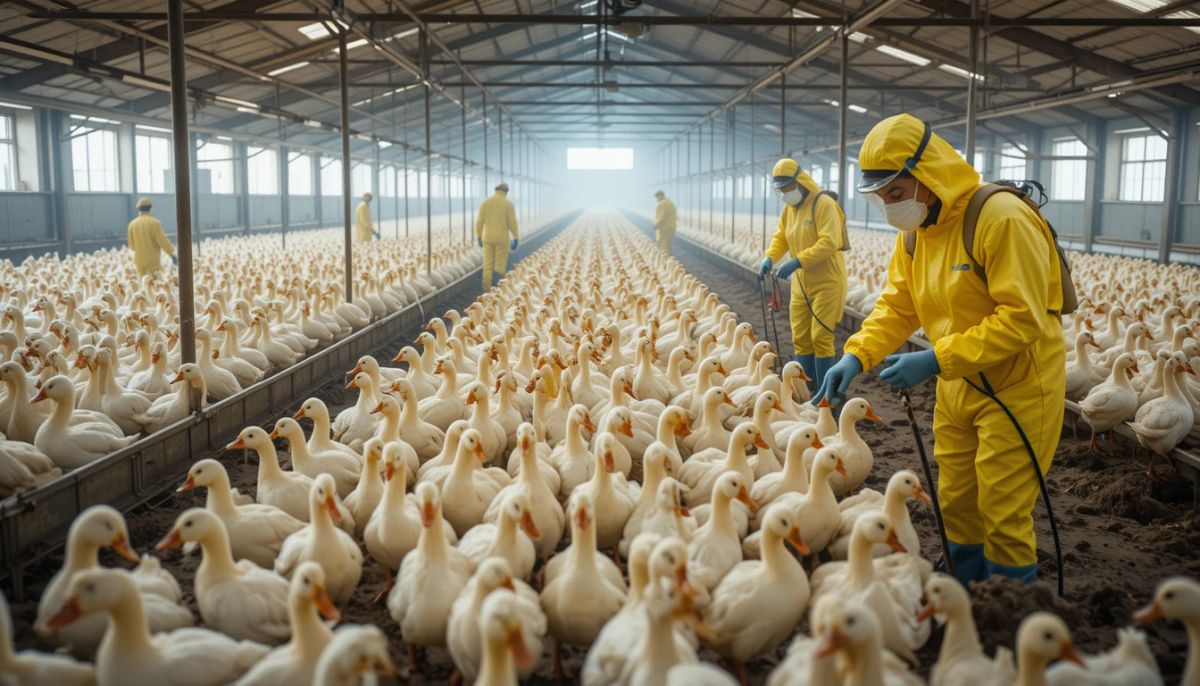The United States has confirmed its first outbreak of the rare H5N9 bird flu strain in poultry, a significant development in the ongoing fight against avian influenza. This event, which took place at a duck farm in Merced County, California, has raised concerns among health officials, virologists, and the poultry industry. Below is a comprehensive breakdown of the outbreak, its implications, and the response efforts.
What Is H5N9 Bird Flu?
H5N9 is a subtype of the highly pathogenic avian influenza (HPAI) virus. It is a reassorted variant that combines genetic material from existing H5N1 strains with other avian flu viruses containing the N9 neuraminidase. Known for its ability to cause severe disease in birds, H5N9 has not been widely reported before this U.S. outbreak.
How Does It Differ From H5N1?
- H5N1: A more common strain that has caused widespread outbreaks globally and sporadic human infections.
- H5N9: A rarer strain that emerged through reassortment and has not yet been associated with human cases but poses potential risks due to its genetic makeup.
Details of the Outbreak
The outbreak began on November 23, 2024, at a commercial duck farm in Merced County, California. Nearly 119,000 ducks were affected by both the H5N9 and H5N1 strains. The U.S. Department of Agriculture (USDA) confirmed the presence of H5N9 on January 13, 2025.
Key Facts:
- Location: Merced County, California.
- Impact: All 119,000 ducks on the farm were culled by December 2 to contain the virus.
- Detection: The USDA’s National Veterinary Services Laboratory identified H5N9 during routine testing.
- Quarantine Measures: The affected farm was immediately quarantined to prevent further spread.
Why Is This Significant?
This is the first confirmed case of HPAI H5N9 in U.S. poultry. The emergence of this rare strain raises concerns about its potential to adapt further or reassort with other viruses, including those that infect humans.
Risks Highlighted by Experts
Virologist Angela Rasmussen emphasized that ducks often act as "silent carriers" for avian flu viruses. They can transmit these viruses while showing minimal symptoms themselves. This characteristic makes them ideal hosts for reassortant viruses like H5N9, which could evolve further as they spread.
Public Health Implications
Although there is no evidence yet of human infections from H5N9, experts are closely monitoring its behavior. The Centers for Disease Control and Prevention (CDC) continues to assess the risk to the general public as low but warns that genetic changes in such viruses could increase their transmissibility or severity.
Who Is at Risk?
- Poultry workers.
- Veterinarians and animal health responders.
- Backyard flock owners.
The CDC also highlights concerns about potential reassortment with human flu viruses if the strain infects intermediate hosts like pigs.
Economic and Environmental Impact
Poultry Industry
The culling of nearly 119,000 ducks represents significant economic losses for farmers and disrupts poultry supply chains. Avian influenza outbreaks often lead to trade restrictions on live birds and poultry products.
Wildlife
Migratory birds are natural reservoirs for avian influenza viruses and play a role in their spread across regions. The impact on wild bird populations and biodiversity could be severe if the virus continues to circulate.
USDA Response
The USDA’s Animal and Plant Health Inspection Service (APHIS), along with state and wildlife officials, has launched an extensive investigation into the outbreak:
- Epidemiological Investigation: Tracing the origin of the virus and identifying transmission routes.
- Enhanced Surveillance: Monitoring other poultry farms and wild bird populations for signs of infection.
- Containment Measures: Strict biosecurity protocols have been implemented to prevent further spread.
Global Context
Avian influenza remains a global concern due to its impact on animal health, public health, and international trade. Since 2022, over 136 million birds have been affected by various strains of avian flu in the U.S., highlighting the need for robust surveillance systems.
Conclusion
The detection of H5N9 bird flu in California underscores the ever-evolving nature of avian influenza viruses and their potential risks. While immediate public health risks remain low, vigilance is crucial to prevent further spread and mitigate economic losses. Enhanced biosecurity measures, ongoing research, and international cooperation will be key in addressing this challenge.
FAQs
What makes H5N9 different from other bird flu strains?
H5N9 is a rare reassorted strain combining elements from existing avian flu viruses, making it genetically distinct from more common strains like H5N1.
Can humans get infected with H5N9?
There are no reported human cases of H5N9 so far; however, experts are monitoring its potential to evolve or reassort with human flu viruses.
What measures are being taken to control the outbreak?
The USDA has quarantined affected areas, culled infected birds, and increased surveillance to prevent further spread.
How does this outbreak affect poultry farmers?
Farmers face significant economic losses due to culling operations and trade restrictions imposed during outbreaks.
What can individuals do to protect themselves?
Avoid contact with sick or dead birds, maintain strict hygiene when handling poultry products, and report unusual bird deaths to local authorities.
